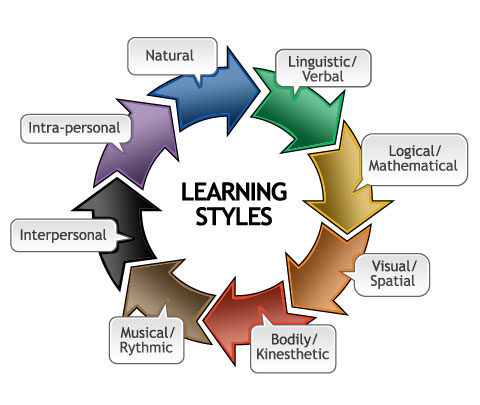Lesson 5: Learning Styles and Self Assessment
Attention
There are lots of ways in which we define the way students are most comfortable learning. The most popular and well-known consists of three distinct "Learning Styles" or "Learning Preferences"

For the purpose of this lesson we will use this model. However, there are other ways in which Learning Styles are defined. Check out this one...it is based on Howard Gardner's Multiple Intelligence Theory...look at all the different kinds of preferred learning styles people can have!

ALL the models tell us something about ourselves...the point of this lesson is to explore what you can do with this knowledge about yourself!
Learning Outcomes
Upon completion of this lesson's material, students will be able to:
- Identify personal learning style preferences
- Reflection on the impact of learning styles on studying and learning
- Identify strategies for personal learning (place/time/value)
- Identify specific strategies for studying and remembering information
Teaching
Finding Your Style
VARK: A Guide to Learning Styles
VARK is a questionnaire that you will take to learn about your own Learning Styles. To explore this test and the factors it measures, visit their website HERE.
Based on this specific test, you will be categorized in one of four styles (or Multimodal):
- Aural
- Visual
- Read/Write
- Kinesthetic
- Multimodal
Review the information on each style by clicking HERE
What do you do with it?
The first thing to keep in mind is that EVERYONE can learning things in ALL the styles...unless a particular style is inhibited by a disability. Having a PREFERRED STYLE does not mean that you need to have all your learning information in that style...it is your PREFERENCE....it is what comes most easily for you.
What is wrong with this cartoon? Assume that the person who is saying "Blah, Blah, Blah..." is the teacher
It is NOT the responsibility of the TEACHER to remember that the STUDENT is a kinesthetic learner!
(Now, many teachers will strive to teach in a way that that addresses all learning styles, but sometimes this is not possible to do)
The STUDENT knows they are a Kinesthetic Learners so they need to take steps to translate the "Blah, Blah, Blah..." into a format that they can study. In this example, the student may choose to take notes on index cards, organize them, and review them as flash cards in order to engage her preferred learning style (Kinesthetic or Tactile) to learn information that is being presented in another style (Auditory)
It is going to be important for you to incorporate ALL learning styles into your skill set....sometimes you are going to have to learn SOME information in other ways that you are not as skilled in...college is a good time to develop those skills.
Emotional Intelligence
Assessment
Lesson 5 Quiz
- Based on what you have learned in this lesson and in your past experience, identify the strategies you have successfully used regarding where you study, the time of day you study, the duration of your study time, and the value or importance you put on your study time (prioritizing studying over other activities).
- Complete the online VARK inventory and comment on the accuracy of this assessment. Reflect on past learning experiences that have been "easy" or "challenging" based on a match between your preferred learning style and the content/style of presentation of the subject.